Metal halide lamps: types, device, pros and cons + selection rules
Despite the development of LED technology, metal halide lamps (MGL) continue to maintain their market niche due to unique characteristics. Their internal arrangement can vary greatly depending on the intended field of application. The characteristic structural types are worth a look. Do you agree?
We will help you deal with the principles of operation and features of the MGL device. In the article we proposed, structural varieties are given, the scope is indicated. Those wishing to purchase such a light bulb will find valuable recommendations for selection from us.
The content of the article:
How are metal halide lamps arranged?
MGL have a complex internal structure. Externally, it is a glass cylinder with a base, although some models look like a pear-shaped incandescent lamp.
Inside the shell is another working capsule made of glass or transparent ceramic, as well as conductive elements and resistors.
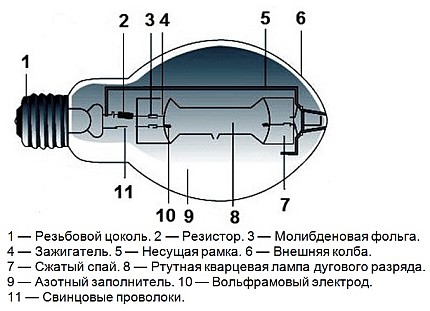
The outer bulb is usually filled with nitrogen, while the inner one is filled with an inert gas under pressure, a small amount of mercury and metal halide additives. This design determines the name of the product.
Sodium iodide or scandium is mainly used as metal halides. They serve to correct the light spectrum and affect the scope of metal halide lamps. In the off state, mercury and additives are in a solid precipitated state on glass walls.
On its own, when connected to the electric network, MGL will not turn on. To do this, start-up control devices (PRA) are used, which provide the necessary starting current and voltage until the effect of thermionic emission in the inner flask.
Light emission mechanism
The inclusion of MGL occurs in stages. Initially, due to an inrush current 10-20 times higher than the operating current, a minimal electric discharge occurs in the inert gas medium in the inner flask.
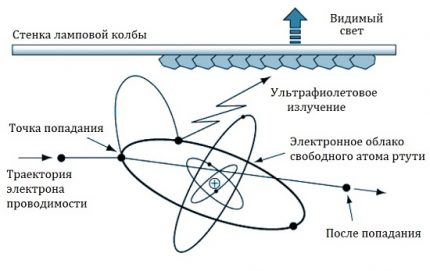
After that, within 3-6 minutes, the mercury and metal halides are heated, which, evaporating, pass into the ionized phase. The current at this time is approximately 2 times higher than the working one. Ions increase the conductivity of the air mixture, and provide a gradual exit of the lamp to the nominal luminosity.
Due to the two-bulb device, a stable high temperature is maintained in the working capsule, which prevents the deposition of metal vapor on the walls. After shutting down, the MGL must necessarily cool down, and the metal vapors settle on the walls of the inner bulb. Only after that it will be possible to restart the lamp.
This restriction is a significant minus, so metal halide lamps are not used in domestic needs, where it is often necessary to turn on / off the lighting. Gravity also affects the condensation processes in MGL, so many models require a clearly defined spatial arrangement.
The principle of operation of discharge lamps is not simple, but it allows you to achieve the correct spectrum and powerful light flux. In addition, the use of ballasts allows you to stabilize the characteristics of the emitted light during fluctuations in the parameters of the power supply network.
MGL structural varieties
Metal halide lamps are used to illuminate both corridors and rooms, as well as large open industrial sites. Therefore, their power varies from 10 to 2000 watts.
Lamps with high energy consumption are usually connected to a 380 V network and are used only at industrial facilities. The most popular models have a small power of 35-250 watts.

There are no common international standards for labeling MGL, but in most cases the letter M means “metal halide”, and H indicates the mercury content in the lamp.
Domestic manufacturers can use their abbreviation: D - arc; And - iodide, P - mercury. After specifying the model, the type and diameter of the base are usually indicated.
Metal halide lamps have a different design.
The following are the classification options for these products, depending on their technical parameters:
- By type of orientation: vertical (BUD), horizontal (BH), universal (U).
- By the size of the flask: BT - bulb-tubular, R - reflex, E or ED - ellipsoidal, ET - ellipsoid-tubular, T - tubular, PAR - parabolic.
- By the color of the radiation: white, yellow, purple, green and others.
- By design type: baseless - with flexible down conductors, single-base, double-base.
The external design of a metal halide lamp has little effect on its efficiency, because the direct emitting element is located in a protected inner bulb. It is he who determines the characteristics of the emitted light.
Technical features of lamps
Technical characteristics of MGL are quite diverse. They depend on the materials used in the production and the electrical parameters of the metal halide lamps. These devices have pronounced advantages and disadvantages that you should be aware of when buying.
General operating parameters
Metal halide luminaires are not picky about external temperature and continuous operation. They can burn for weeks at sub-zero temperatures without experiencing overloads.
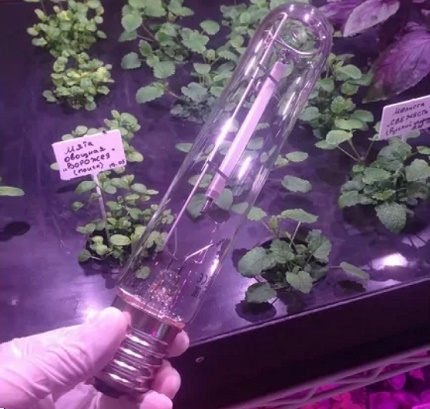
The main parameters that characterize MGL are:
- color rendering index (CRI);
- work resource;
- power;
- light flow;
- view of the cap;
- Colour temperature;
- the ratio of light flux to electric power;
- working temperature.
Color rendering index is considered an important characteristic of MGL. CRI characterizes the presence in the emitted spectrum of different wavelengths and the uniformity of their intensity.
This indicator is measured as a percentage of similarity with natural daylight. In modern MGL, the color rendering index is 85-95%, and in most household LED devices - 70-85%.
Some lamps intentionally distort the color rendering to give the light the necessary properties. For example, sodium MGL, used for plant growth, have a CRI of only 50-60%. The efficiency of the lamp does not fall from this, just the majority of the energy it emits in a given wavelength range.
To give light a yellow tint, sodium halides are used, green - thallium, blue - indium. With regard to performance, the metal halide lamps do not lag behind led bulbs. This indicator for both devices in the middle price range is 100-120 lm / W.
The color temperature of MGL can be from 2500-20000 ° K. When the voltage drops in the network, it changes in the direction of increase and the light becomes colder. If the indicator exceeds 240 V for a long time, the lamp may simply explode due to overheating of the gas-air mixture in the inner bulb.
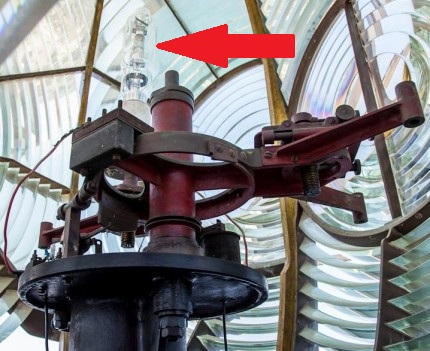
An important quality of MGL is the stability of the luminous flux over the entire period of operation, which is 6-15 thousand hours. If the efficiency of LEDs after 10,000 hours of operation drops by about 50%, then for metal halide lamps - only by 2-20%.
The remaining parameters depend on the specific model of the luminaire and are not specific.
The benefits of metal halide lamps
The modern market for discharge lighting is slowly shrinking due to the onset of LEDs. But the unique properties of MGL for at least a few decades will be in demand by consumers.
The main advantages of these lamps are:
- Excellent energy efficiency. For every watt of energy consumed, the lamp produces more than 100 lm of light.
- High level of color rendering index.
- A sophisticated manufacturing technology that minimizes breakdowns of the internal elements of the lamp.
- Wide range of capacities.
- Long service life.
- Resistance to high temperatures due to the lack of electronic components inside the lamp.
Metal halide devices compete primarily with LED and fluorescent tubes. All three technologies are actively developing, therefore, further improvement can be expected from MGL.
Negative sides of the device
The absence of metal halide lamps in the domestic sphere indicates that they have not only positive, but also negative qualities.
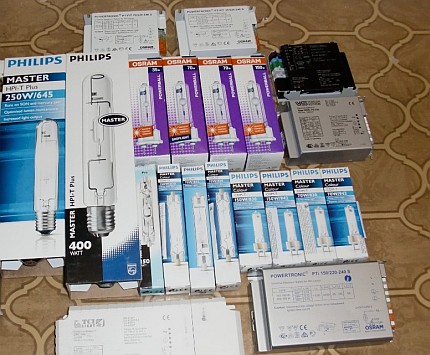
The main disadvantages of MGL are:
- The cost is several times higher than similar LED devices.
- Lack of brightness control.
- The need for cooling for 5-10 minutes before re-starting.
- The presence of an external ballast, which requires additional space for installation.
- Gradual increase color temperature with prolonged use.
- Explosion hazard during power surges.
- Sensitivity to spatial arrangement.
- Absolute non-repairability.
- The need for special disposal due to the content of toxic substances.
- The need for time to reach the calculated luminous flux after switching on.
Thus, they have more minuses than pluses. This narrows the scope of MGL to industrial and public buildings and sites where continuous and high-quality lighting is needed.
Scope of fixtures
The use of metal halides at home is not only economically irrational, but also dangerous due to the content of mercury in them. The flask may burst and the room will be filled with toxic fumes.
Due to insecurity, mainly the use of metal halide lamps is in demand only mainly for non-residential spaces:
- Film studios, photo studios.
- Car lights.
- Architectural buildings.
- Public buildings, shopping and entertainment center.
- Industrial workshops.
- Objects under construction.
- Street lighting.
- Sports objects.
- Park areas.
- Greenhouse complexes, greenhouses.
- Night illumination of country houses.
Most people don’t even have to buy MGL because these devices are rarely sold in small hardware stores. They are mainly acquired by enterprises and entrepreneurs from specialized companies.
How to choose a metal halide lamp?
Application specificity discharge light bulbs Forces a careful approach to the selection of their characteristics. Of course, the goods can always be exchanged, but it is better to immediately acquire the appropriate model.
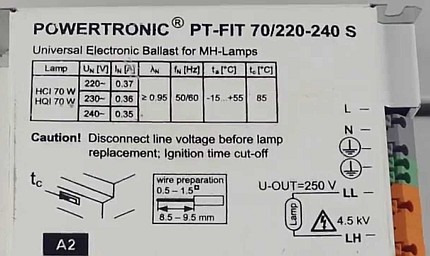
The main recommendations for the purchase of metal halides are as follows:
- Carefully read the labels on the package, which may inform about the restriction of the use of MGL in certain circumstances.
- The declared operating position of the product must correspond to the position of the lamp for which it is intended. The least resource for vertically oriented models.
- The diameter of the base must fit under the lamp holder.
- The starter housing must be made of metal with a sufficient number of ventilation holes. Indeed, depending on the model, the ballast consumes 10-20% of the lamp power.
- The starting device is designed for a specific voltage and current, so when replacing the lamp, these factors must be taken into account.
- In some cases, fast ignition of the MGL is critical, therefore, the time of its reaching the nominal luminosity must be read in advance in the instructions.
If a metal halide lamp is purchased to replace a failed one, then you can take a broken model with you to the store for example.
MGL are expensive, so it is important to keep all receipts and invoices when buying, so that you can use the warranty rights later.
Compare metal halide devices with halogen bulbs information will help next articledevoted to the analysis of the characteristics of the model G4.
Conclusions and useful video on the topic
Video # 1. Overview of the characteristics of metal halide lamps:
Video # 2. Checking the operation of the metal halide floodlight:
Video # 3. Metal halide lamp connection:
Metal halide lamps continue to be used in many areas, despite a number of design flaws.A diverse spectrum of radiation allows you to select them for various needs of economic activity. Therefore, MGL will remain competitive for a long time in the niche of industrial lighting.
Please write comments in the block below, ask questions, post a photo on the topic of the article. Share your own guidelines for choosing a metal halide bulb. Tell us why you chose this particular device.

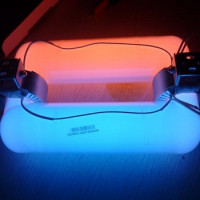 Induction lamps: device, types, scope + rules of choice
Induction lamps: device, types, scope + rules of choice 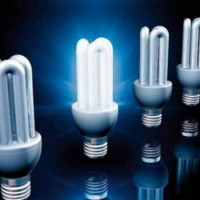 Fluorescent lamps: parameters, device, circuit, pros and cons compared to others
Fluorescent lamps: parameters, device, circuit, pros and cons compared to others 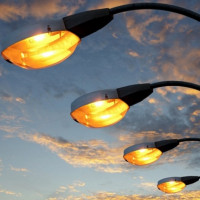 DRL lamps: device, characteristics, selection rules
DRL lamps: device, characteristics, selection rules  LED table lamps: types, selection rules + review of the best manufacturers
LED table lamps: types, selection rules + review of the best manufacturers  LED lamps "Jazzway": reviews, pros and cons of the manufacturer + model overview
LED lamps "Jazzway": reviews, pros and cons of the manufacturer + model overview  G4 halogen lamps: features, pros and cons + rating of light bulb manufacturers
G4 halogen lamps: features, pros and cons + rating of light bulb manufacturers  How much does it cost to connect gas to a private house: the price of organizing gas supply
How much does it cost to connect gas to a private house: the price of organizing gas supply  The best washing machines with dryer: model rating and customer tips
The best washing machines with dryer: model rating and customer tips  What is the color temperature of light and the nuances of choosing the temperature of the lamps to suit your needs
What is the color temperature of light and the nuances of choosing the temperature of the lamps to suit your needs  Replacement of a geyser in an apartment: replacement paperwork + basic norms and requirements
Replacement of a geyser in an apartment: replacement paperwork + basic norms and requirements